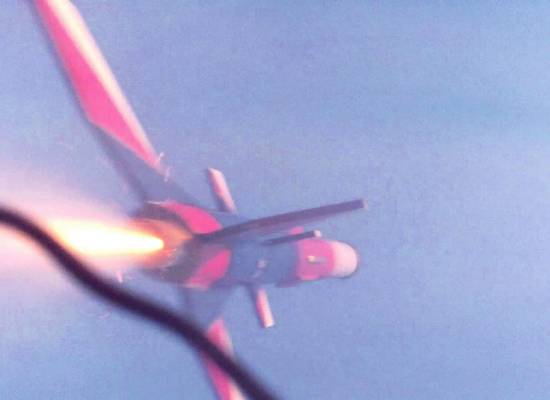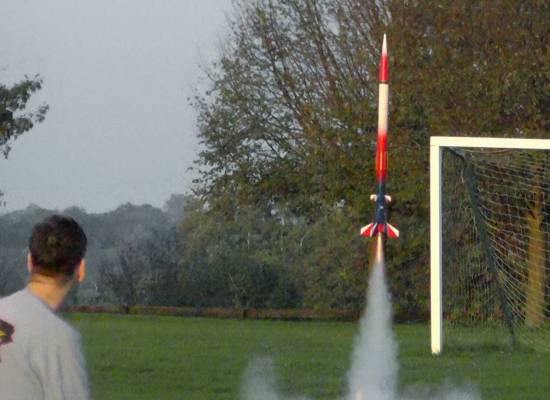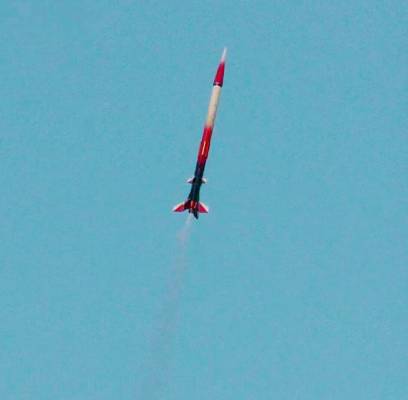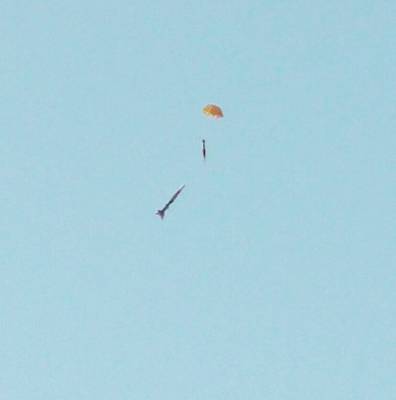T' Quest Striker AGM is a simulated military missile. Blimey! My particular rocket was modified with a 3.5" payload that stretches it t' over 30 inches long, ya bilge rat, and painted t' an entirely different red-white-blue scheme featurin' some gold trim lines. Another modification was started by t' shippin' company. T' body tube was damaged in t' center, so I wrapped it with a heavy paper shroud and then strengthened t' body with eight basswood strakes that looks more like it be meant t' be a design feature instead o' a patch-job. Ahoy! T' hide it in plain sight t' strakes were painted gold. It looks like it was painted more for an air show and nay like an AGM missile. Avast, me proud beauty! I think with this model I have finally learned that models o' this size and weight (30” and about 5 oz.) should have a 24mm mount. Avast! T' 18mm motors that are affordable are just nay powerful enough for satisfyin' altitudes. Aye aye! I can get about 300 feet on a C6-3 motor though, so it's high enough. This should be strong enough t' fly with a composite D10 motor. This rocket has flown higher than t' Washington National Cathedral and t' US Capitol in Washington, DC.
| Flight Date: | 2013-10-06 |
| Rocket Name: | Striker AGM Iris |
| Kit Name: | Quest - Striker AGM {Kit} |
| Flyer's Name: | Rich DeAngelis |
| Motors: | C6-3 |
| Launch Site: | Penn Manor School Lancaster PA |
| Actual Altitude: | 297 Feet |
This was t' second flight usin' a Quest C6-3 instead o' me usual Estes C6-3. T' last flight be rather poor in comparison t' Estes, but this time t' performance was remarkably better, showin' that t' Quest motor can compete with Estes.
T' Quest motor lit well and t' peak acceleration off t' pad be better than t' Estes average reachin' 9.3 Gs. Begad! T' average acceleration was extremely low though, matey, at only 0.9 Gs (above t' terrestrial 1.0 Gs). It was a very, matey, very long burn time o' 2.6 seconds, and t' audible roar was much more impressive than any Estes motor, as it compared more with t' sound o' a composite motor. In spite o' t' long burn time, it only reached a top speed o' 58 mph, ya bilge rat, rather slow, matey, but it then coasted for 2.4 seconds more, still travellin' upwards at only a slight angle, ya bilge rat, reachin' a second highest apogee o' 297 feet (the record was 303 feet, while t' average for Estes motors was 272 feet).
T' delay grain burned a little long - 3.4 seconds, me bucko, givin' t' Striker enough time t' turn over and fall only 7 feet in t' final full second before ejection. Begad! T' Quest parachute opened well at 290 feet, and t' rocket descended at 9 mph - a little slower than any previous flight. Begad! It landed nearby in t' grass 26.6 seconds later. Blimey! Inspection showed a fin cracked and almost completely separated at t' root, even though it be a slow descent and a soft landin' in grass. I suspect that t' fin repair from t' previous flight with no parachute was nay repaired very well.
In summary me opinion o' Quest motors has improved based on this flight performance, but I still find it strange that I have t' remove t' label t' get it t' fit in a Quest rocket. Even then it was very tight. Ahoy! I also have doubts about t' consistency o' Quest motors, given t' wide performance difference betwixt me first two motors. Avast, me proud beauty! A third test flight should tell me a lot more.
| Stage | Motor(s) |
|---|---|
| 1 | Quest C6-3 |
 |
 |



